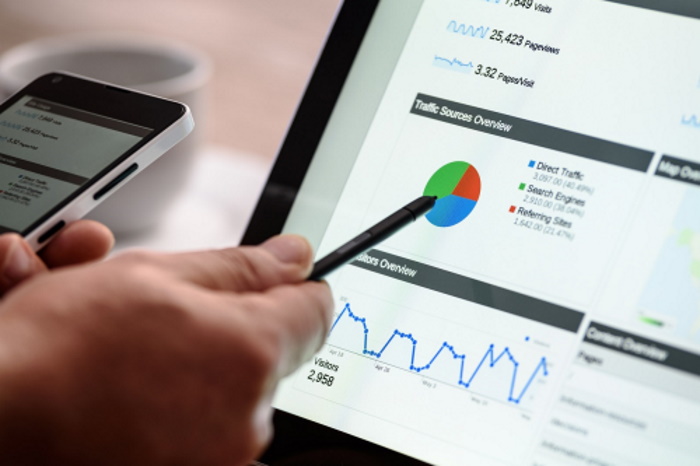Digital analytics have become a vital tool for businesses in the digital age. Understanding how to use this powerful technology can greatly improve business operations and increase profits. This article provides an overview of the basics of digital analytics, discussing its purpose, benefits, and key concepts.
The aim is to equip readers with the knowledge they need to make informed decisions about their own data-driven projects. By better understanding what digital analytics is, how it works, and why it’s so important, readers will be able to use it more effectively within their own organisations. This beginner’s guide focuses on helping readers understand the basics of digital analytics. It gives them important information that helps them get powerful insights from their data sets.
This beginner’s guide focuses on helping readers understand the basics of digital analytics. It gives them important information that helps them get powerful insights from their data sets. It offers an introduction to topics such as setting up tracking codes, web page optimization strategies, segmentation techniques, and more. With these tools in hand, readers should feel empowered to take control of their online presence and maximise their success in today’s competitive market.
Definition of Digital Analytics
Digital analytics is the practise of collecting, analysing, and interpreting data from online sources to gain insights into user behaviour. It allows businesses to measure, understand, and optimise their digital presence in order to improve customer experience, drive growth, and increase revenue. Digital analytics also provides organisations with invaluable intelligence about their target market, enabling them to make better decisions around their marketing strategies and product development.
Web analytics tools such as Google Analytics and Adobe Analytics, social media platforms like Facebook Insights, and qualitative tools like Decibel and Medallia can be used to collect digital analytics data. This data can then be analysed using descriptive statistics, predictive modelling techniques, A/B testing, or other statistical methods to identify patterns that help inform business decisions.
Digital analytics should be used to keep an eye on how well a website is doing and to keep track of how users interact with content across various digital channels. Companies can make better campaigns and products that meet customers’ needs if they know how people use their websites and apps. Also, this information can be used to make targeted ads that are made for different groups of people to increase engagement and conversion rates.
Types of Digital Analytics Tools
Digital analytics tools are essential for businesses that want to understand and optimize their online presence. These tools provide valuable insights into customer behaviour and can help businesses make data-driven decisions. There are various types of digital analytics tools available, each with its unique features and benefits. In this article, we’ll explore the different types of digital analytics tools and how they can benefit your business.
1. Web Analytics Tools
Web analytics tools are the most commonly used digital analytics tools. They help businesses analyse website traffic and user behaviour. With web analytics tools, you can track metrics such as page views, bounce rates, and session duration. These tools also provide insights into the demographics of your website visitors, such as their age, gender, and location. This information can help businesses improve their website’s user experience and target their marketing efforts more effectively.
One of the most popular web analytics tools is Google Analytics. It is a free tool that provides businesses with detailed insights into their website traffic. Google Analytics can track various metrics such as traffic sources, user behaviour, and conversion rates. It also provides businesses with reports that can help them understand their website’s performance and identify areas for improvement.
2. Social Media Analytics Tools
Social media analytics tools help businesses analyse their social media performance. These tools provide valuable insights into how users are engaging with your social media content. With social media analytics tools, you can track metrics such as likes, shares, comments, and follower growth. This information can help businesses understand which types of content are resonating with their audience and optimise their social media strategy accordingly.
One popular social media analytics tool is Hootsuite. It is a comprehensive social media management tool that allows businesses to track their social media performance across various platforms. Hootsuite provides businesses with insights into their social media engagement, follower growth, and top-performing content. It also allows businesses to schedule and publish social media content directly from the platform.
3. Email Marketing Analytics Tools
Email marketing analytics tools help businesses track the performance of their email marketing campaigns. These tools provide insights into how users are engaging with email content, such as open rates, click-through rates, and conversion rates. With email marketing analytics tools, businesses can optimise their email marketing campaigns to increase engagement and drive conversions.
One popular email marketing analytics tool is Mailchimp. It is a comprehensive email marketing platform that provides businesses with detailed insights into their email campaigns. Mailchimp can track various metrics such as open rates, click-through rates, and revenue generated from email campaigns. It also provides businesses with tools to create and optimise email content, automate email campaigns, and segment their email lists.
4. Mobile Analytics Tools
Mobile analytics tools help businesses track their mobile app performance. With mobile analytics tools, businesses can track metrics such as app installs, user behaviour, and retention rates. This information can help businesses understand how users are interacting with their mobile app and optimise their app’s user experience accordingly.
One popular mobile analytics tool is Firebase. It is a comprehensive mobile app development platform that provides businesses with detailed insights into their app performance. Firebase can track various metrics such as app installs, user behaviour, and retention rates. It also provides businesses with tools to optimise their app’s user experience, such as A/B testing and personalised messaging.
5. PPC Tools
PPC tools help businesses track and optimise their paid advertising campaigns. These tools provide insights into which ads are performing best, which keywords are driving the most traffic, and which landing pages are converting the most visitors. With PPC tools, businesses can optimise their advertising campaigns to increase conversions and ROI.
One popular PPC tool is Google Ads. It is a comprehensive advertising platform that allows businesses to create and manage ads across various platforms, including search, display, and video. Google Ads provides businesses with detailed insights into their ad performance, such as click-through rates, conversion rates, and cost-per-click. It also provides businesses with tools to optimise their ad targeting and bidding strategies.
6. A/B Testing Tools
A/B testing tools help digital teams optimise their website and marketing campaigns by testing different variations of content. These tools provide insights into which changes are working best and can help digital teams make data-driven decisions about their website and marketing strategy.
One popular A/B testing tool is Optimizely. It is a comprehensive optimization platform that allows businesses to test different variations of website content, such as headlines, images, and calls-to-action. Optimizely provides businesses with insights into which variations are performing best and can help businesses optimise their website for conversions.
If you want to use data to make smart decisions, it’s important to understand the capabilities and use cases of the different types of digital analytics tools. With this knowledge, digital teams can then move on to identify which specific key performance indicators (KPIs) are most important for their operations and how they will use them to measure success.
Key Performance Indicators (KPIs)
As a digital team, keeping track of your performance is essential for success. But what metrics should you be measuring? What are the key performance indicators (KPIs) that every digital team should follow? In this article, we’ll explore the different types of KPIs that are critical to monitoring, measuring, and improving your digital performance.
1. Acquisition KPIs
Acquisition KPIs are a set of metrics that measure how effectively you are generating traffic to your website or app and also the quality of that traffic. These metrics help you understand how effective your marketing campaigns are in attracting and engaging your target audience.
Examples of such KPIs include number of visits or users, cost per session, cost per conversion, bounce rate, and conversion rate.
2. Engagement KPIs
Engagement KPIs help you measure how your audience interacts with and responds to the content across your digital touchpoints and products. These metrics will help you understand how well your website is engaging and retaining your target audience.
Examples of such metrics include time on site, pages per session, interaction rates, and content consumption rates.
3. Conversion KPIs
Conversion KPIs measure how well your website or app is converting visitors into customers. These metrics help you understand how well your website is performing in terms of generating revenue and driving business growth.
Examples of these metrics include goal completion rates, conversion rate, and average order value.
4. Retention KPIs
Retention KPIs measure how well your website is retaining customers and driving repeat usage. These metrics help you understand how well your website is building customer loyalty and driving business growth.
Examples of these include customer retention rate, repeat purchase rate, churn rate, and customer lifetime value.
5. Technical KPIs
Technical KPIs measure the performance and health of your website’s technical infrastructure. These metrics help you understand how well your website is performing in terms of speed, reliability, and user experience.
Examples of these include page load time, server uptime, mobile responsiveness, and security stability.
How to Set Goals for Digital Analytics
Setting goals for digital analytics is an important step towards successful data-driven decision making. Goals should be set at the outset of any project to ensure that all parties involved have a clear understanding of what will be accomplished and how success will be measured. This section outlines some key considerations when setting up goals in order to make sure they are achievable and measurable.
The first step is to set SMART goals, which stand for Specific, Measurable, Attainable, Relevant, and Timely. Having specific metrics for each goal can help focus attention on a certain area and make it more likely that the desired results will be reached. Also, by making sure each goal is attainable, stakeholders can better manage their expectations and avoid being let down if unrealistic goals are set. Also, the importance of each goal should be judged so that resources aren’t wasted on tasks that may not add much value or make a big difference overall. Lastly, setting a deadline helps teams stay motivated throughout the process by making it clear when things need to be done.
To sum up, if you want to set good goals for digital analytics, you need to think carefully about their purpose and how it fits with your strategic goals. You also need to see if you can reach them in the time you have. With these elements taken into account, organisations can then use this information to track progress against their defined outcomes over time, giving them greater control over their analytical initiatives.
Having clear goals in place is an important step for any business looking to succeed with digital analytics. With these objectives set, the next step is creating a strategy that will guide your team towards achieving them.
Creating a Digital Strategy
Having a solid digital strategy is crucial for businesses that want to succeed in today’s digital age. A digital strategy is the plan that outlines how a business will utilise its digital channels and technologies to achieve its goals. This usually involves leveraging a range of digital marketing techniques, such as social media, email marketing, and search engine optimization, to build brand awareness, drive traffic to a website or app, and convert leads into customers with conversion rate optimisation and personalisation. The key to success is to tailor the digital strategy to the unique needs of your business, and to regularly review and update the plan to keep it relevant in the ever-changing digital landscape. By having a solid digital strategy in place, your business can effectively engage with their audience, build their brand, and drive growth and success.
A successful digital strategy is made up of three main parts:
- Understanding your customer journeys
- User segmentation and personalisation
- Keeping track of your digital performance
Understanding your customer journeys
The first step in making a digital strategy is to get a clear picture of how customers interact with your brand online. This involves mapping out all potential touchpoints between consumers and your-company’s website or app and how they can be measured. This could include user research, usability testing, and clickstream analysis. By identifying areas where users may be frustrated or confused, it becomes easier to create content or adjust design elements to better meet their needs. Additionally, analysing the paths taken by visitors can help determine which channels are most effective at driving conversion rates.
User segmentation and personalisation
The next step is to identify your key customer segments, determine what drives engagement from them, and leverage this data to drive personalisation. Segmentation allows businesses to group their audience according to various criteria, such as age range or geographic location, so they can tailor messages accordingly. Combining this information with insights gained from customer journey analysis enables companies to develop personalised experiences across multiple channels on both mobile and desktop devices.
Keeping track of your digital performance
Finally, no digital strategy would be complete without measuring its efficacy over time using specific KPIs (Key Performance Indicators). These indicators can vary depending on your industry and/or business model, but generally involve tracking the commercial value generated by the usage of your digital products and efforts from the marketing team. Keeping track of your KPIs will provide insight into what works best within your digital function and help your teams optimise their strategies going forward.
Making Data-Driven Changes
Once the data has been collected and analysed, the next step is to implement changes based on that information. Implementing changes can be a difficult process as it involves making decisions about how best to use the new insights gained from the analytics work to improve performance or operations. It requires an understanding of the business context and goals, as well as clear communication with stakeholders about expected results.
The first step in implementing change is to identify opportunities for improvement within the organisation; this could involve areas such as marketing campaigns, customer service initiatives, product design, website structure, and usability testing. Once these have been identified, data-driven solutions should be explored, which will help determine the most effective approach towards achieving desired outcomes. This could include using predictive analytics techniques to come up with future-proof solutions or running A/B tests to compare different versions of content or UX against each other.
Lastly, once the right strategies have been chosen, it’s important to make sure they’re put into action well by making detailed plans and keeping track of their success through regular analysis of analytics data. This helps ensure that any improvements made have a positive impact on the overall digital performance and allows necessary adjustments to be made if required.
The Role of Artificial Intelligence in Digital Analytics
The use of artificial intelligence (AI) in digital analytics is rapidly growing. AI is being used to analyse vast amounts of data that can help companies make more informed decisions about their business or marketing strategies. AI-driven digital analytics has become an essential tool for businesses to gain valuable insights into customers’ preferences and market trends.
AI capabilities like machine learning, natural language processing, and deep learning are used to quickly and accurately find patterns in large datasets. With the help of these technologies, marketers can gather information on their target customers’ behaviour and interests, which they can then use to tailor campaigns that will be better received by audiences. Additionally, AI-driven digital analytics enables companies to optimise their websites and other online properties, improving the user experience and increasing conversions.
By using AI-powered digital analytics tools, marketers and product managers can have access to a wide range of insights, including demographics, purchase history, website activity, social media engagement, search engine queries, and much more. This gives them greater control over how they reach out to potential customers while also providing opportunities for segmentation based on different criteria. As a result, businesses can improve their decision making processes and increase efficiency when it comes to targeting specific segments with tailored messages and offers.
The Impact of Big Data on Digital Analytics
Big Data has had a significant impact on the digital analytics industry. It has created an unprecedented level of insight into customer behaviour and preferences, allowing organisations to develop more effective marketing campaigns and gain competitive advantages over their rivals. Big Data also enables businesses to identify opportunities for improvement in areas such as pricing, product positioning, customer segmentation, and resource allocation. This can result in faster decision making processes and improved organisational effectiveness.
With the rise of “big data,” companies can now collect vast amounts of data from many different sources, both online and offline. As a result, this vast amount of data must be managed effectively in order to ensure accuracy. Companies are now able to analyse large volumes of data quickly and accurately with the help of advanced analytical tools like machine learning algorithms and artificial intelligence (AI). These technologies provide insights that would have previously been impossible to obtain from traditional approaches alone.
Also, these newer methods let users take advantage of predictive analytics, which lets them predict future trends based on what has happened in the past.
In addition, big data has led to the development of smarter applications that utilise AI-enabled interfaces for customers’ convenience. Such features include automated recommendations or personalised content tailored specifically for each user’s needs. With access to accurate information about consumer behaviour, organisations can improve their offerings while ensuring they remain aligned with current market dynamics at all times, ultimately helping them stay ahead in today’s ever-changing business landscape.
The Future of Digital Analytics
With the advances in technology, digital analytics is becoming more sophisticated. This increased sophistication has enabled businesses to make better decisions by using accurate data and insights from their web traffic. As such, there are a number of new trends emerging within this field.
One trend that is gaining traction is the shift towards predictive analytics. With predictive analytics, companies can use existing data to forecast future outcomes with greater accuracy. In addition, they can also use artificial intelligence (AI) and machine learning algorithms to gain deeper insights into customer behaviour and preferences. Additionally, AI-based tools allow businesses to automate tasks like segmentation and optimisation for improved efficiency and effectiveness.
Another trend in digital analytics is the increase in personalisation features being offered by companies. By leveraging user profiles generated through advanced tracking technologies, organisations can tailor their services according to individual users’ needs and preferences. Furthermore, automated marketing campaigns based on behavioural analysis have become increasingly popular amongst marketing teams as they offer higher engagement rates than traditional advertising methods.
These trends demonstrate how digital analytics continues to evolve at a rapid pace to keep up with the ever-changing demands of digital users and landscape. With its ability to provide powerful insights into consumer behaviours, it will no doubt remain an essential part of any company’s digital strategy going forward.
Conclusion
Digital analytics is an area of digital marketing that is evolving rapidly, and it is becoming more and more important for businesses to know how to use this capability to their benefit.
By leveraging digital analytics techniques such as tracking user behaviour on websites and mobile applications or measuring customer engagement across social media platforms, businesses are able to gain insights into their customers that would otherwise be impossible. This helps them optimise their digital touchpoints and increase customer satisfaction by providing personalised experiences that appeal directly to the target audience. Furthermore, advances in artificial intelligence technologies allow companies to automate processes like segmentation and predictive modelling, which further streamline operations and lead to increased efficiency.
The future trends for digital analytics will focus heavily on automation through AI-driven approaches. As businesses continue to embrace new technologies such as machine learning algorithms and cloud computing solutions, their scale and ability to gather valuable insights about customer preferences will continue to evolve rapidly. By keeping an eye out for emerging trends within the industry, organisations have the potential to stay ahead of the competition while still creating meaningful relationships with their digital users.
Thank you for taking the time to read our blog post. At Swayven Digital, our mission is to help product and marketing teams take their analytics game to the next level. If you’d like to learn more about our services and how we could assist you, please don’t hesitate to get in touch with us. Remember, the next level of your analytics journey is just a conversation away.
Stay tuned for more insights, and until next time, keep optimising!





